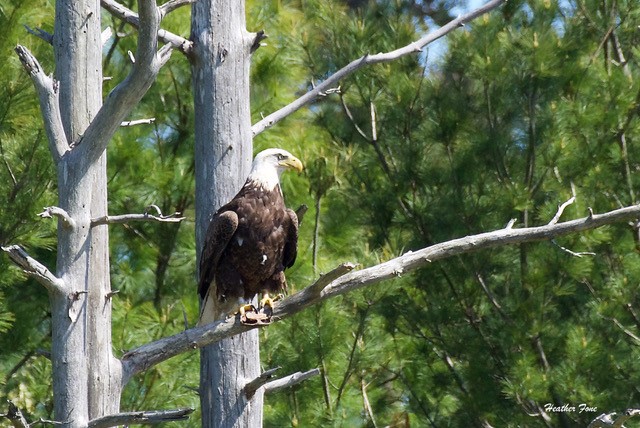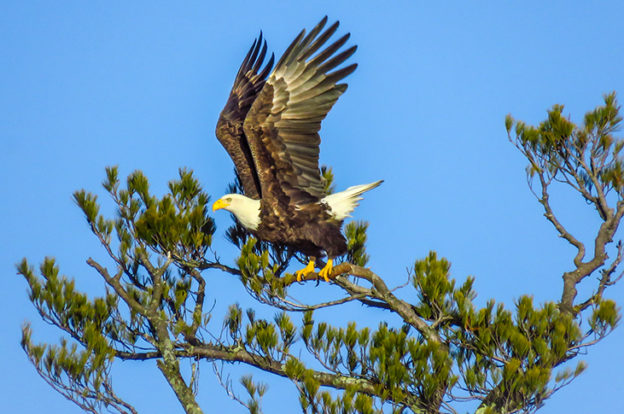The Massachusetts Division of Fisheries and Wildlife (MassWildlife) recently confirmed that there are now more than 70 active Bald Eagle nests in the Bay State, including the first nesting effort on Cape Cod since 1905.

This nest, located in a white pine tree, was discovered many months ago by a homeowner’s association and reported to MassWildlife. Subsequently, Josh Maloney, a burgeoning nature enthusiast and volunteer at Mass Audubon’s Long Pasture Wildlife Sanctuary discovered what appeared to be a chick in this nest in late May.
Josh carefully mapped the location of the nest, documented the chick with photographs, and reported the sighting to MassWildlife state ornithologist Andrew Vitz. Within days, Mass Wildlife ascended the tree and banded the eaglet in order to gather valuable life history information throughout its life and contribute to eagle research across the country. We are hopeful this chick will fledge in the coming weeks, and that this breeding pair will return to this nest annually for many years to come.
Bringing Eagles Back to Massachusetts

This historic benchmark is a living testament to the conservation efforts initiated in Massachusetts by Mass Wildlife and Mass Audubon in response to the significant regional decrease in the population of Bald Eagles that took place throughout the Northeast as a result of DDT use during the 1950s and 1960s.
In 1982, two healthy young eagle nestlings from Michigan were foster reared in a specially constructed tower in a remote section of the Quabbin Reservoir in central Massachusetts. Using a captive rearing protocol called hacking, the two fledglings were eventually released with hopes that upon reaching maturity in four to five years, they would return to the Quabbin area to breed. Between 1982 and 1988, 41 similarly raised eagle chicks were released at Quabbin Reservoir. By 1989 two pairs successfully reared young of their own.
Since the late 1980s, the Commonwealth’s eagle population has steadily grown and spread. Today pairs of this magnificent raptor are nesting from Berkshire to Barnstable County, and recently they have attempted to colonize Martha’s Vineyard.
Impact of Conservation
Thanks to the efforts of hundreds of Massachusetts citizen scientists who contributed the valuable breeding bird distribution data, Mass Audubon ornithologists now have two invaluable roadmaps to help highlight nesting species in need of state conservation assistance. This includes not only include Bald Eagles, but also declining grassland species such as American Kestrel, Bobolink, and Eastern Meadowlark.
In spite of last year’s chilling national report on 3 billion missing birds in “Decline of the North American Avifauna,” species recoveries like those shown by the Bald Eagle, Osprey, Peregrine Falcon, Piping Plover, and Eastern Bluebird offer clear evidence that it is never too late to implement sustained conservation efforts, and that many species will often dramatically respond.
These species offer clear evidence why Mass Audubon’s bird conservation efforts continue to make a difference, and why financial support for avian conservation programs is more important than ever.



We had a pair of Bald Eagles nesting in our woods about 10 years ago and there were a lot of them nesting along the Merrimack River. There seem to be more fish up in the bigger river than in the Blackstone.
I remember the first time I saw a Bald Eagle sitting on a telephone pole on Martha’s Vineyard. He was immature. Big, but still entirely brown. But who could mistake that beak!
White Island pond in Plymouth Mass has two Bald Eagles every winter
I am a resident of Cape Cod and nesting bald eagles on Cape Cod is such wonderful, refreshing news in a world of pandemic and economic worry. In fact, learning that 70 nesting pair of eagles in Massachusetts is incredible and shows the dedicated work of so many individuals and organizations. Let’s hope nature will continue on this path, and that people can learn from this and enjoy all nature has to offer!